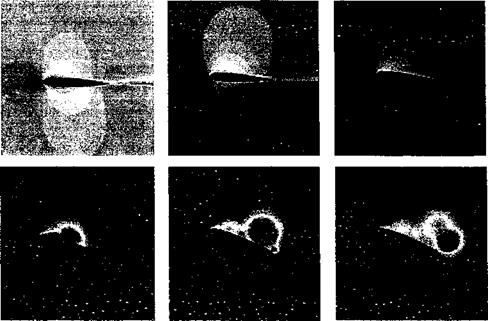Dynamic Stall
The problem of dynamic stall has been discussed extensively in Chapter 9. The proper and complete prediction of dynamic stall, however, continues to elude the helicopter aerodynamicist. This is because dynamic stall is characterized by the appearance of large, recirculating, turbulent separated flow regimes near the surface of the airfoil. While
|
Figure 14.7 A series of predicted pressure fields surrounding an airfoil during a blade – vortex interaction at transonic speeds, (a) Vortex upstream of airfoil, (b) Vortex interacts with airfoil, (c) Vortex passes downstream of airfoil, (d) Vortex passes into downstream wake. Source: Lee & Baeder (2002) and courtesy of Yik-Loon Lee. |
parsimonious models including stall effects can be developed for use in rotor analyses (i. e., models for integrated lift, drag and pitching moment – see Section 9.5.1), sensible predictions (as opposed to reconstructions or postdictions) of the overall flow field during dynamic stall can be obtained only by solving numerically the full Navier-Stokes equations along with a suitable representation of turbulent flow effects. To this end, CFD methods that include some representation of turbulent flow effects via turbulence closure models have begun to show promise in predicting 2-D and 3-D dynamic stall events – see, for example, Srinivasan et al. (1993), Ekaterinaris et al. (1994), Barakos et al. (1998), and Martin, Chandrasekhara, & Geissler (2003). It should be noted, though, that many widely different turbulence models have been developed over the years, the most popular perhaps including those developed by Baldwin & Lomax (1978), Spalart & Allmaras
(1992) , and others, as reviewed by Marvin & Huang (1996), but that the selection of the most appropriate model for any particular flow problem is still very much an open question.
|
Figure 14.8 A sequence of Navier-Stokes predictions showing the shedding of a leading edge vortical disturbance during dynamic stall at low Reynolds number. Source: Barakos et al. (1998) and courtesy of G. Barakos and D. Drikakis. |
An example of a Navier-Stokes prediction of dynamic stall is shown in Fig. 14.8. In these calculations a nonlinear eddy viscosity model was used to represent the turbulence in the flow. Clearly the approach predicts the key characteristic phenomenon of dynamic stall, which is the shedding of a leading edge vortical disturbance – see also Fig. 9.2. However, quantitative predictions of the airloads are not yet satisfactory in the fully stalled regime or during flow reattachment – these techniques have difficulty reproducing the flows at Reynolds numbers and Mach numbers relevant to helicopter rotors. In this regard, the accurate prediction of the transition from a laminar to turbulent boundary layer flow on the airfoil surface prior to the onset of dynamic stall is a key outstanding issue. The complexity of the surface boundary layer flow state on an airfoil under these dynamic AoA conditions is reflected in the measurements of Lee et al. (2000).
Investigation of methods and development of strategies to control and/or alleviate dynamic stall would appear to yield a prime opportunity for CFD methods, and indeed this problem has received some attention. Yet, no one scheme has yet demonstrated clear benefits. The use of zero-mass synthetic jets (see Section 9.12) to delay the onset of flow separation has good potential based on the results of both calculations and experiments. Alternatively, it seems that the use of leading edge slats, or other changes in the leading edge shape of the airfoil, may lead to improvements in alleviating the adverse features of dynamic stall – see Sahin et al. (2000). Studies with variable droop (camber) leading edge airfoils have also been conducted as a means of alleviating dynamic stall related problems – see Geissler & Trenker (2002) and Martin, Chandrasekhara, & Geissler (2003). Any benefits, however, have to be balanced against the possibility of introducing adverse effects on the pitching moments from high camber and overall airfoil performance, and this issue has not yet been researched thoroughly enough to be convincing. The payoffs in terms of improved high-lift and low-drag airfoil designs free of dynamic stall is, however, potentially enormous, because this could lead to quantum gains in helicopter forward speed and/or maneuver performance.













